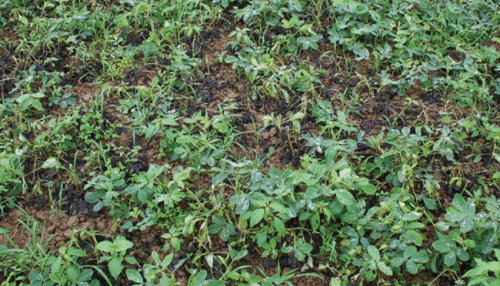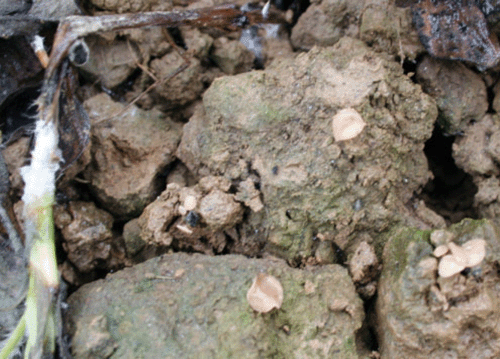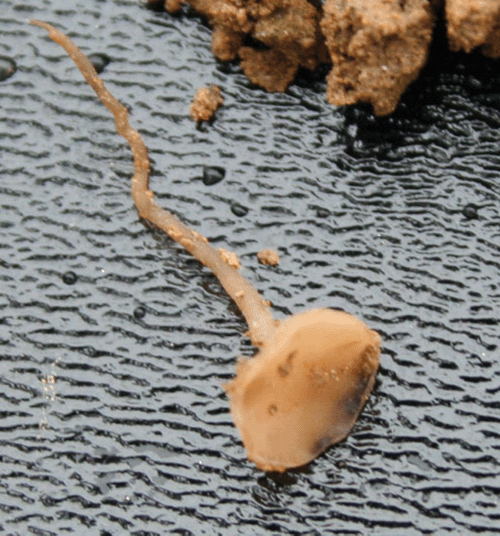First report of Sclerotinia blight caused by Sclerotinia sclerotiorum in Quang Nam, Vietnam
T. M. Luong A , L. M. T. Huynh A , T. V. Le A , L. W. Burgess B D and H. T. Phan CA Quang Nam Plant Protection Sub-Department, Tam Ky, Quang Nam, Vietnam.
B Faculty of Agriculture, Food and Natural Resources, The University of Sydney, NSW 2006, Australia.
C National Institute of Medicinal Materials, Hanoi, Vietnam.
D Corresponding author. Email: burgess.international@gmail.com
Australasian Plant Disease Notes 5(1) 42-44 https://doi.org/10.1071/DN10016
Submitted: 16 April 2010 Accepted: 27 April 2010 Published: 10 May 2010
Abstract
Sclerotinia blight, caused by Sclerotinia sclerotiorum is reported from Quang Nam Province, Vietnam, for the first time. The disease is common in cool wet winter and spring seasons on dwarf and climbing beans, peanuts and occasionally on chilli plants. A serious epidemic occurred in peanuts in some communes in spring 2008, following a period of cool wet weather after the crop canopy had closed and when flowering was well advanced.
Sclerotinia sclerotiorum is an important foliar pathogen affecting a wide range of vegetable and field crops in many countries. Ly et al. (2002) first reported Sclerotinia sclerotiorum in Vietnam, on cabbages near Hanoi. They also observed apothecia (pictured on page 111 in Burgess et al. 2008). More recently Dang Vu Thi Thanh (2008) has cited the occurrence of S. sclerotiorum in Ha Noi, Ha Tay, Nam Ha and Lao Cai provinces in her compendium on fungal diseases of crop plants in Vietnam.
In January 2006, the authors found Sclerotinia blight (stem rot) in dwarf beans and climbing beans (Phaseolus vulgaris) in Dai An commune, Dai Loc district, Quang Nam, Vietnam, following a period of cool wet weather. The disease was observed during systematic surveys of diseases of vegetable crops, as part of the training program in a capacity building project funded by the Australian Centre for International Agricultural Research (ACIAR) (Burgess and Burgess 2009). Apothecia were commonly associated with the occurrence of diseased plants. Samples of diseased stems were collected for isolation studies in the laboratory. The stems were washed thoroughly in tap water, surface-sterilised by dipping briefly in 70% ethyl alcohol, immediately rinsed in sterile water and damp-dried on sterile paper tissue. Small segments from the margins of healthy and diseased tissue were plated on water agar. Fungal colonies that developed from the segments were sub-cultured to potato dextrose agar (PDA). All colonies recovered were typical of S. sclerotiorum and produced abundant large black sclerotia on PDA. A representative colony was purified by hyphal tipping (Burgess et al. 2008), and the pure culture accessioned as QN10 in the culture collection at the diagnostic laboratory of the Quang Nam Plant Protection Sub-Department (PPSD). This culture was used to inoculate dwarf beans using the stem-inoculation technique described in Burgess et al. (2008). Typical stem rot was reproduced and the pathogen formed sclerotia on the diseased tissue. The fungus was isolated from the inoculated plants into pure culture, completing Koch’s postulates.
Beans are usually planted in late December in Quang Nam, following the end of the wet season. The beans flower during January when cool wet conditions are common, which favour the germination of sclerotia and the formation of apothecia. As the release of ascospores can coincide with the dropping of old flowers into leaf axils, ideal conditions for infection may be present. The role of senescent flowers in the infection process of S. sclerotiorum has been documented (McLean 1958; Cook et al. 1975; Abawi and Grogan 1979).
Field meetings were held with district staff and farmers to explain the disease cycle and the importance of crop rotation to reduce inoculum levels in soil, and the timely application of fungicide so as to ensure effective penetration of the crop canopy before the onset of wet conditions. There is potential for host resistance to contribute to an IDM strategy for this disease in peanuts in the future (Cruickshank et al. 2002).
Sclerotinia stem rot was also observed in chilli in Dien Quang Commune, Dien Ban District, Quang Nam in 2007. However the incidence was quite low.
In Quang Nam in 2008 cool wet conditions prevailed from January to early March, by which time peanuts planted in January had developed a closed canopy. The monthly rainfall for January, February and March in 2007 was 217 mm, 10 mm, and 207 mm respectively, with corresponding mean monthly temperatures of 21°C, 19°C and 23°C. Peanuts in some areas were planted on land cropped regularly to peanuts and dwarf beans. Sclerotinia blight (Figs 1, 2) was reported from the northern districts, namely Dien Ban, Dai Loc and Duy Xuyen Districts by the district staff of the Quang Nam PPSD. However, it was particularly common and severe in Dai Hong Commune, Dai Loc District, with crop losses of up to 80%. Apothecia were present in all diseased crops surveyed in this commune (Figs 3, 4). S. sclerotiorum was successfully isolated into pure culture using the methods described above.

|

|

|

|
This appears to be the first serious epidemic of Sclerotinia blight caused by S. sclerotiorum in peanuts in Quang Nam. As the blight developed in lower stems and branches under the crop canopy, the severity of the disease was not realised until warmer weather increased transpiration rates causing sudden and severe wilting and plant collapse. At this time it was too late for effective fungicide application.
Dai Hong Commune was not included in earlier disease surveys by the ACIAR project team in Quang Nam. Consequently the history of the occurrence of Sclerotinia blight in this commune is not known. However, it is assumed that sclerotial levels in soil had increased gradually over several years to relatively high levels. The weather in the growing season in 2007 was cool and wet similar to that in 2008. In 2008 the coincidence of cool wet weather and a closed canopy with dead flowers provided ideal conditions for an epidemic. We also observed sclerotia of Sclerotium rolfsii on the bases of several plants affected severely by S. sclerotiorum.
It is noteworthy that S. sclerotiorum was the only Sclerotinia species observed in the field based on size of sclerotia and the abundance of apothecia. This finding contrasts with the situation in the USA where S. minor is reported to be the dominant species causing Sclerotinia blight in peanuts (Kokalis-Burelle et al. 1997). However, in Australia both S. sclerotiorum and S. minor are considered important pathogens of peanuts (Cruickshank et al. 2002). The differences in the relative importance of the two species as pathogens of peanuts in different regions may reflect differences in cropping systems or subtle differences in climatic conditions during the growing season. The popularity of dwarf and climbing beans in Quang Nam may have favoured a build-up of sclerotia of S. sclerotiorum as these crops are quite susceptible to this pathogen (Schwartz et al. 2005). Further surveys are warranted in Quang Nam and other peanut-growing provinces to determine if S. minor is present in peanuts or indeed, in other crops, in Vietnam.
Acknowledgements
The authors gratefully acknowledge financial support from the Australian Centre for International Agricultural Research through CP/2002/115 – Diseases of crops in the central provinces of Vietnam: diagnosis, extension and control (2005–2008).
Abawi GS, Grogan RG
(1979) Epidemiology of diseases caused by Sclerotinia species. Phytopathology 69, 899–904.
| Crossref | GoogleScholarGoogle Scholar |

Burgess LW, Burgess JS
(2009) Capacity building in plant pathology: soilborne diseases in Vietnam, 1993–2009. Australasian Plant Pathology 38, 325–333.
| Crossref | GoogleScholarGoogle Scholar |

Cook GE,
Steadman JR, Boosalis MG
(1975) Survival of Whetzelinia sclerotiorum and initial infection of dry edible beans in western Nebraska. Phytopathology 65, 250–255.
| Crossref | GoogleScholarGoogle Scholar |

Cruickshank AW,
Cooper M, Ryley MJ
(2002) Peanut resistance to Sclerotinia minor and S. sclerotiorum. Australian Journal of Agricultural Research 53, 1105–1110.
| Crossref | GoogleScholarGoogle Scholar |

McLean DM
(1958) Role of dead flower parts in infection of certain crucifers by Sclerotinia sclerotiorum (Lib.) D By. Plant Disease Reporter 42, 663–666.



